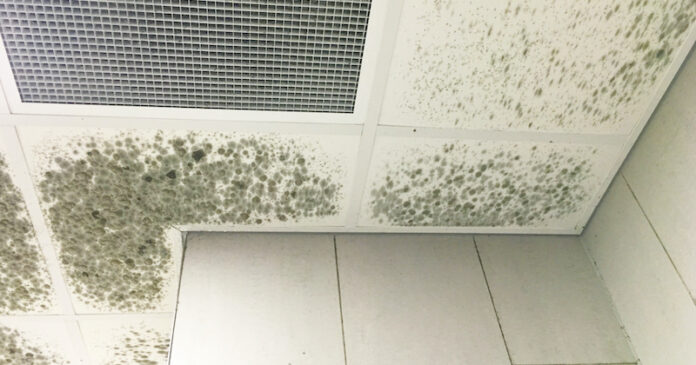
Tips For Mold Risk, Mold and hazard mitigation should be a top priority ahead of reopening a previously inactive property, especially if you plan on welcoming back employees.
By Stuart Kerr, MD
Due to the COVID-19 pandemic, many properties have been temporarily shuttered, or running reduced operations. During a period of inactivity such as this, mold can develop, breed, and spread within a facility, contaminating the environment for its occupants. During inactivity, a building is most susceptible to mold risks and hazards, especially if maintenance has been inconsistent or a low priority.
From plumbing failures to problematic moisture build-ups and poor air quality, mold hazards are most dangerous when left untreated or unidentified. Prevention, the ideal solution to treating mold, is only as effective as a property manager’s ability to identify areas likely of this risk.
Mold breakouts often develop through climbing humidity levels, or poor building ventilation. This is worsened by certain conditions within a property and can be impacted depending on different seasons and weather patterns.

Unfortunately, mold can develop discreetly. When this happens, expert remediation can treat an environment, helping it return to its state before it was contaminated with mold. That’s why minimizing risk – and overall trying to prevent mold – can only be achieved when building maintenance is consistent, even when a building is unoccupied.
Preventing And Minimizing Mold Risk
Prevention is the most reliable method for treating hazards such as mold. Mold often develops in out-of-sight locations, which means that it can spread unnoticed. These kinds of contaminations become harder to contain, especially where the premise has been inactive for a period of time.
Preventing and detecting mold is a crucial task for facility managers. The following four steps should be part of an assessment before reopening a building to the workforce:
1. Be watchful of humidity.
Mold is most likely to develop within a property if the humidity levels are irregular and exceed 50%. Facility managers will need to assess and evaluate indoor humidity with proper equipment to accurately gauge the likelihood of a mold infestation. A digital hygrometer can offer accurate readings of humidity, which will indicate risk of mold.
Monitoring for mold, based on spikes in humidity readings, should form a part of a strategy to inspect the building’s ongoing conditions, regardless of any occupants. Under certain conditions, mold growth can accelerate within a matter of days, which is why regular assessments are essential.
2. Performing risk assessments as a strategy.
Unoccupied or empty buildings should be inspected regularly for risks. Seek out mold growths or symptoms of risks, such as dampness, smells, or other irregularities. Learn the signs of mold growth and consistently test for symptoms. Identifying mold or other hazards in a building should be a top priority for its reopening.
3. Investigate plumbing issues and damage.
Similar to ventilation, mold breeds and multiplies when conditions are favorable. Plumbing failures, such as leaks and water damage, can often result in a hazard or damage. That’s because moisture helps mold materialize, especially in areas impacted by water damage and build-up.
Areas that attract moisture are hotspots for mold activity, even if it’s not visibly present. Mold can form around pipes, or around doorways and window frames. If moisture levels rise, then an escalation of this risk will mean that an expert consultation with a restoration specialist will help recover a building from contamination.
4. Assess ventilation before activating it.
HVAC systems which have been dormant can help conceal developments of mold, especially if fungal growths are disguised behind vents. Where a building is temporarily inactive or running as a reduced operation, HVAC systems may be underused. This can be an opportunity for surface contamination or other unhygienic activity to occur. This is particularly dangerous after a period of inactivity, because unclean ventilation shafts will help spread toxic or harmful mold spores throughout a building infrastructure.
Prior to activating ventilation systems, be sure to assess for hidden mold growth throughout a building. Containing mold before it can break out is key for future prevention and establishing a clean building, including air quality, for its occupants.
Understanding The Hazards
Mold can be identified by its symptoms, either as property damage or for its negative effects on human health. Mold will develop visibly as a cluster of spores, which materializes on interior surfaces. Mold is unsightly and it can be identifiable by its musty or damp smell.
Mold is considered a health and safety hazard which can develop on interior surfaces within a building including tiles, carpets, wallpapers, and other fabrics. Certain conditions promote these hazards, such as exposure to dampness, excessive moisture, or condensation
Mold is just as hazardous to a building’s health as it is to the occupants of a facility. According to the Centers for Disease Control (CDC), mold is “toxigenic” and can undermine human health either by causing allergic reactions or by polluting air quality for those with asthma and other respiratory conditions.
Learning about the signs and symptoms of mold can help facility managers track and prevent hazards from developing within a building. Knowing how to identify this risk and treat it appropriately is key to future prevention.
Tips For Mold Risk Written by Stuart Kerr, MD
